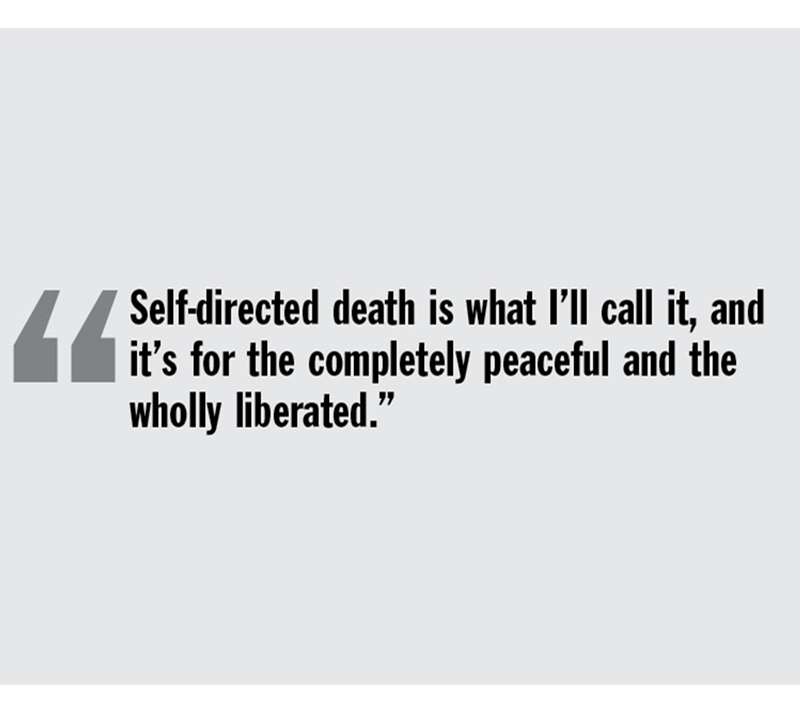I admire Brittany Maynard.
The 29-year-old Oregon woman and terminal brain cancer sufferer took a doctor-sanctioned lethal concoction Saturday, ending her life when and where she wanted — at home in her bed with her family surrounding her.
Besieged by seizures, debilitating head pain and given six months to live last spring, Maynard became a religious and medical hot potato once she went public for declaring her right to die, a choice made even more debatable because she and her husband moved from California to Oregon to take advantage of that state’s Death With Dignity Act.
Several medical ethicists spoke up against it, saying it is the physician’s very oath and therefore job to do everything to keep patients alive and comfortable until the “natural” end.
Another woman in another state also suffering with terminal brain cancer posted a video online reading Maynard a letter pleading with her to “step in off the ledge” and “stay with us” a little while longer.
But Maynard did what was best for her, wishing for her husband to continue on with his life and to fulfill his dream of becoming a father.
I am now comfortable saying I think about death all the time; indeed, everyday. And not in that generic, middle-aged, discovering-my-own-mortality way, either.
I am talking now about listening to the nearly imperceptible hourly failures of my own body and realistically counting down the days when it — this encasement given to me in God’s lottery — will tire of my failed attempts to master diabetes, asthma, chronic nerve pain and just quit.
Or maybe, just maybe, I will be my family’s next recipient of some form of cancer — breast, stomach, brain, pancreatic, lung — that has befallen so many other family members I sometimes have to drag out funeral programs to count cancer’s wins.
The coal dust my grandfather and oldest uncle Clarence brought into the house in Chattaroy, West Virginia, 80 or more years ago is probably the culprit for much of the cancer on my mother’s side, but so are excessive smoking and drinking.
So, realistically, I know any of this can get me, including a stroke or heart attack as collateral damage from diabetes.
Therefore, I have been randomly talking about death to my partner in sentences that begin with: “When I die...”
I have my mother to thank and to blame for much of my comfort with death and morbidity. I cannot recall one childhood era or year when Gladine wasn’t talking to her children openly and honestly about death — her death. From the years when we were all in single digits to the day she died in Mercy Hospital in May 2005, we all already knew what to do and what not to do when the day came.
Do not resuscitate.
“I don’t want anyone wiping me, feeding me, trying to figure out what I’m saying or leaning over me if I can’t do anything for myself,” she’d say in a loop that lasted nearly until she took her final, unaided breath.
When I was 5 years old, it seemed abstract and obtuse.
When I was 40 years old it was our directive.
Kenny held the power of attorney, and while mom was in a medically induced coma while doctors monitored her progress after the Whipple Procedure nearly gutted her clean out, we had The Talk.
“Well,” Kenny began tentatively and in a heavy sigh, “we definitively know what to do.” The papers were signed and the rest was a waiting game.
Kenny was bedside when mom took her last breaths, and I sometimes wonder if he ever thought about a last-minute reversal; if he ever wanted to call the nurses in for CPR or oxygen or whatever it is they do.
Randy and I arrived in time to unzip the flimsy white body bag and to kiss her still-warm cheek. I looked at her peaceful and smooth face and knew her lifelong wish not to be revived was absolutely the right thing for her and for us.
And with all this right to die rhetoric, I have been thinking about this: What really is the difference between dying with dignity, as Maynard did, and choosing not to be revived, as our mother did?
With the former, the patient is dying with a physician’s assistance, with a medical cocktail given by a physician; in the latter, the patient is perhaps dying passively, as physicians and medical staff do nothing to interfere with the final death rattle.
Is dying with dignity so politicized because the doctor is so actively involved?
But couldn’t patients just as easily stockpile their own toxic pain killers for that day when they’re done with the pain, the fighting, the basement-level quality of life, with seeing the anguish on the faces of loved ones they maybe cannot even identify any longer?
If doctors take an oath to “do no harm,” then isn’t abiding by the eternal wishes of a woman racked with agonizing pain whose death is already inevitable the right thing to do?
Death, I know, isn’t for the faint-hearted.
It isn’t for people merely trying to get attention or for cowards who can’t suck up the hardships life throws all of us; death isn’t meant to be abused like we abuse Facebook or the Internet.
Death isn’t an easy out.
It is for people who are packed and ready to go; for folks who’ve made their beds, made their peace and who’ve looked into the face of whatever god they know or whichever one they’ve been avoiding and have said “Here I come” or “There I go.”
Self-directed death is what I’ll call it, and it’s for the completely peaceful and the wholly liberated. It’s not to appease or to placate. It is to be respected.
If given the choice, I’ll say when and where and it’ll be one of the few times I’ll have had complete control over my life.






